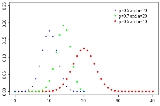
List of probability distributions
Encyclopedia
Many probability distribution
s are so important in theory or applications that they have been given specific names.
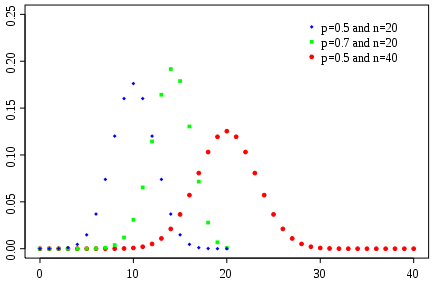
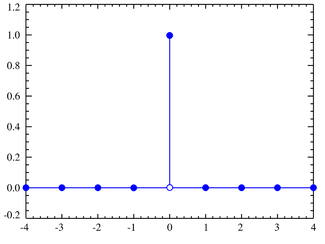
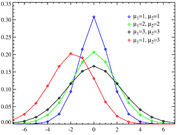
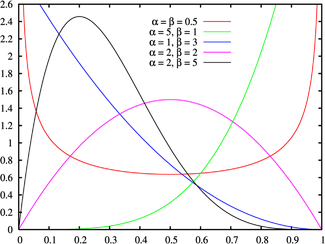
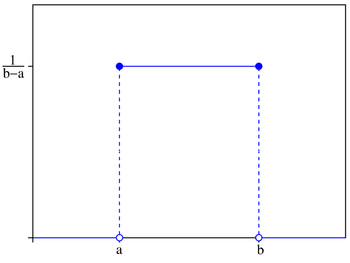
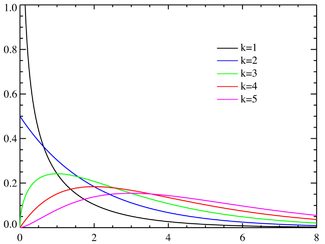
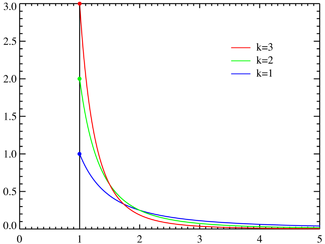
Supported on semi-infinite intervals, usually
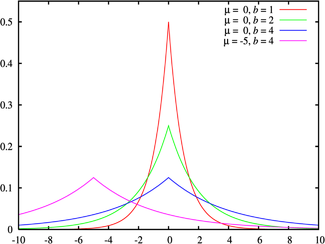
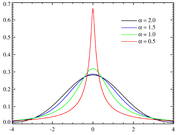
random variables the probability density function
of their joint distribution
is the product of their individual density functions.
Probability distribution
In probability theory, a probability mass, probability density, or probability distribution is a function that describes the probability of a random variable taking certain values....
s are so important in theory or applications that they have been given specific names.
Discrete distributions


With finite support
- The Bernoulli distribution, which takes value 1 with probability p and value 0 with probability q = 1 − p.
- The Rademacher distribution, which takes value 1 with probability 1/2 and value −1 with probability 1/2.
- The binomial distribution, which describes the number of successes in a series of independent Yes/No experiments all with the same probability of success.
- The beta-binomial distribution, which describes the number of successes in a series of independent Yes/No experiments with heterogeneity in the success probability.
- The degenerate distribution at x0, where X is certain to take the value x0. This does not look random, but it satisfies the definition of random variableRandom variableIn probability and statistics, a random variable or stochastic variable is, roughly speaking, a variable whose value results from a measurement on some type of random process. Formally, it is a function from a probability space, typically to the real numbers, which is measurable functionmeasurable...
. This is useful because it puts deterministic variables and random variables in the same formalism. - The discrete uniform distribution, where all elements of a finite setSet theorySet theory is the branch of mathematics that studies sets, which are collections of objects. Although any type of object can be collected into a set, set theory is applied most often to objects that are relevant to mathematics...
are equally likely. This is the theoretical distribution model for a balanced coin, an unbiased die, a casino roulette, or the first card of a well-shuffled deck. - The hypergeometric distribution, which describes the number of successes in the first m of a series of n consecutive Yes/No experiments, if the total number of successes is known. This distribution arises when there is no replacement.
- The Poisson binomial distribution, which describes the number of successes in a series of independent Yes/No experiments with different success probabilities.
- Fisher's noncentral hypergeometric distributionFisher's noncentral hypergeometric distributionIn probability theory and statistics, Fisher's noncentral hypergeometric distribution is a generalization of the hypergeometric distribution where sampling probabilities are modified by weight factors...
- Wallenius' noncentral hypergeometric distributionWallenius' noncentral hypergeometric distributionIn probability theory and statistics, Wallenius' noncentral hypergeometric distribution is a generalization of the hypergeometric distribution where items are sampled with bias....

With infinite support
- The beta negative binomial distribution
- The Boltzmann distributionBoltzmann distributionIn chemistry, physics, and mathematics, the Boltzmann distribution is a certain distribution function or probability measure for the distribution of the states of a system. It underpins the concept of the canonical ensemble, providing its underlying distribution...
, a discrete distribution important in statistical physicsStatistical physicsStatistical physics is the branch of physics that uses methods of probability theory and statistics, and particularly the mathematical tools for dealing with large populations and approximations, in solving physical problems. It can describe a wide variety of fields with an inherently stochastic...
which describes the probabilities of the various discrete energy levels of a system in thermal equilibriumThermal equilibriumThermal equilibrium is a theoretical physical concept, used especially in theoretical texts, that means that all temperatures of interest are unchanging in time and uniform in space...
. It has a continuous analogue. Special cases include:- The Gibbs distribution
- The Maxwell–Boltzmann distribution
- The Bose–Einstein distribution
- The Fermi–Dirac distribution.
- The extended negative binomial distributionExtended negative binomial distributionIn probability and statistics the extended negative binomial distribution is a discrete probability distribution extending the negative binomial distribution. It is a truncated version of the negative binomial distribution for which estimation methods have been studied.In the context of actuarial...
- The geometric distribution, a discrete distribution which describes the number of attempts needed to get the first success in a series of independent Yes/No experiments.
- The logarithmic (series) distribution
- The negative binomial distributionNegative binomial distributionIn probability theory and statistics, the negative binomial distribution is a discrete probability distribution of the number of successes in a sequence of Bernoulli trials before a specified number of failures occur...
, a generalization of the geometric distribution to the nth success. - The parabolic fractal distributionParabolic fractal distributionIn probability and statistics, the parabolic fractal distribution is a type of discrete probability distribution in which the logarithm of the frequency or size of entities in a population is a quadratic polynomial of the logarithm of the rank...
- The Poisson distributionPoisson distributionIn probability theory and statistics, the Poisson distribution is a discrete probability distribution that expresses the probability of a given number of events occurring in a fixed interval of time and/or space if these events occur with a known average rate and independently of the time since...
, which describes a very large number of individually unlikely events that happen in a certain time interval.- The Conway–Maxwell–Poisson distribution, a two-parameter extension of the Poisson distributionPoisson distributionIn probability theory and statistics, the Poisson distribution is a discrete probability distribution that expresses the probability of a given number of events occurring in a fixed interval of time and/or space if these events occur with a known average rate and independently of the time since...
with an adjustable rate of decay.
- The Conway–Maxwell–Poisson distribution, a two-parameter extension of the Poisson distribution
- The Skellam distribution, the distribution of the difference between two independent Poisson-distributed random variables.
- The Yule–Simon distribution
- The zeta distribution has uses in applied statistics and statistical mechanics, and perhaps may be of interest to number theorists. It is the Zipf distribution for an infinite number of elements.
- Zipf's law or the Zipf distribution. A discrete power-lawPower lawA power law is a special kind of mathematical relationship between two quantities. When the frequency of an event varies as a power of some attribute of that event , the frequency is said to follow a power law. For instance, the number of cities having a certain population size is found to vary...
distribution, the most famous example of which is the description of the frequency of words in the English language. - The Zipf–Mandelbrot law is a discrete power law distribution which is a generalization of the Zipf distribution.
Continuous distributions


Supported on a bounded interval
- The Arcsine distribution on [a,b], which is a special case of the Beta distribution if a=0 and b=1.
- The Beta distribution on [0,1], of which the uniform distribution is a special case, and which is useful in estimating success probabilities.
- The Logitnormal distribution on (0,1).
- The Dirac delta functionDirac delta functionThe Dirac delta function, or δ function, is a generalized function depending on a real parameter such that it is zero for all values of the parameter except when the parameter is zero, and its integral over the parameter from −∞ to ∞ is equal to one. It was introduced by theoretical...
although not strictly a function, is a limiting form of many continuous probability functions. It represents a discrete probability distribution concentrated at 0 — a degenerate distribution — but the notation treats it as if it were a continuous distribution. - The continuous uniform distributionUniform distribution (continuous)In probability theory and statistics, the continuous uniform distribution or rectangular distribution is a family of probability distributions such that for each member of the family, all intervals of the same length on the distribution's support are equally probable. The support is defined by...
on [a,b], where all points in a finite interval are equally likely.- The rectangular distribution is a uniform distribution on [-1/2,1/2].
- The Irwin-Hall distributionIrwin-Hall distributionIn probability and statistics, the Irwin–Hall distribution, named after Joseph Oscar Irwin and Philip Hall, is probability distribution for a random variable defined as sum of a number of independent random variables, each having a uniform distribution...
is the distribution of the sum of n i.i.d. U(0,1) random variables. - The Kent distribution on the three-dimensional sphere.
- The Kumaraswamy distributionKumaraswamy distributionIn probability and statistics, the Kumaraswamy's double bounded distribution is a family of continuous probability distributions defined on the interval [0,1] differing in the values of their two non-negative shape parameters, a and b....
is as versatile as the Beta distribution but has simple closed forms for both the cdf and the pdf. - The logarithmic distribution (continuous)
- The raised cosine distribution on [
 ].
]. - The triangular distribution on [a, b], a special case of which is the distribution of the sum of two independent uniformly distributed random variables (the convolution of two uniform distributions).
- The truncated normal distributionTruncated normal distributionIn probability and statistics, the truncated normal distribution is the probability distribution of a normally distributed random variable whose value is either bounded below or above . The truncated normal distribution has wide applications in statistics and econometrics...
on [a, b]. - The U-quadratic distributionU-quadratic distributionIn probability theory and statistics, the U-quadratic distribution is a continuous probability distribution defined by a unique quadratic function with lower limit a and upper limit b.-Parameter relations:...
on [a, b]. - The von Mises distribution on the circle.
- The von Mises-Fisher distribution on the N-dimensional sphere has the von Mises distribution as a special case.
- The Wigner semicircle distribution is important in the theory of random matrices.


Supported on semi-infinite intervals, usually [0,∞)
- The Beta prime distribution
- The chi distribution
- The chi-squared distribution, which is the sum of the squares of n independent Gaussian random variables. It is a special case of the Gamma distribution, and it is used in goodness-of-fit tests in statisticsStatisticsStatistics is the study of the collection, organization, analysis, and interpretation of data. It deals with all aspects of this, including the planning of data collection in terms of the design of surveys and experiments....
.- The inverse-chi-squared distribution
- The noncentral chi-squared distribution
- The Scaled-inverse-chi-squared distribution
- The Dagum distribution
- The exponential distributionExponential distributionIn probability theory and statistics, the exponential distribution is a family of continuous probability distributions. It describes the time between events in a Poisson process, i.e...
, which describes the time between consecutive rare random events in a process with no memory. - The F-distribution, which is the distribution of the ratio of two (normalized) chi-squared distributed random variables, used in the analysis of varianceAnalysis of varianceIn statistics, analysis of variance is a collection of statistical models, and their associated procedures, in which the observed variance in a particular variable is partitioned into components attributable to different sources of variation...
. It is referred to as the beta prime distribution when it is the ratio of two chi-squared variates which are not normalized by dividing them by their numbers of degrees of freedom.- The noncentral F-distributionNoncentral F-distributionIn probability theory and statistics, the noncentral F-distribution is a continuous probability distribution that is a generalization of the F-distribution...
- The noncentral F-distribution
- Fisher's z-distribution
- The folded normal distributionFolded Normal DistributionThe folded normal distribution is a probability distribution related to the normal distribution. Given a normally distributed random variable X with mean μ and variance σ2, the random variable Y = |X| has a folded normal distribution. Such a case may be encountered if only the magnitude of some...
- The Gamma distribution, which describes the time until n consecutive rare random events occur in a process with no memory.
- The Erlang distribution, which is a special case of the gamma distribution with integral shape parameter, developed to predict waiting times in queuing systems
- The inverse-gamma distribution
- The half-normal distributionHalf-normal distributionThe half-normal distribution is the probability distribution of the absolute value of a random variable that is normally distributed with expected value 0 and variance σ2. I.e...
- Hotelling's T-squared distribution
- The inverse Gaussian distributionInverse Gaussian distribution| cdf = \Phi\left +\exp\left \Phi\left...
, also known as the Wald distribution - The Lévy distribution
- The log-Cauchy distributionLog-Cauchy distributionIn probability theory, a log-Cauchy distribution is a probability distribution of a random variable whose logarithm is distributed in accordance with a Cauchy distribution...
- The log-Laplace distributionLog-Laplace distributionIn probability theory and statistics, the log-Laplace distribution is the probability distribution of a random variable whose logarithm has a Laplace distribution. If X has a Laplace distribution with parameters μ and b, then Y = eX has a log-Laplace distribution...
- The log-logistic distributionLog-logistic distributionIn probability and statistics, the log-logistic distribution is a continuous probability distribution for a non-negative random variable. It is used in survival analysis as a parametric model for events whose rate increases initially and decreases later, for example mortality from cancer following...
- The log-normal distribution, describing variables which can be modelled as the product of many small independent positive variables.
- The Mittag–Leffler distribution
- The Pareto distribution, or "power law" distribution, used in the analysis of financial data and critical behavior.
- The Pearson Type III distributionPearson distributionThe Pearson distribution is a family of continuous probability distributions. It was first published by Karl Pearson in 1895 and subsequently extended by him in 1901 and 1916 in a series of articles on biostatistics.- History :...
- The Rayleigh distribution
- The Rayleigh mixture distribution
- The Rice distributionRice distributionIn probability theory, the Rice distribution or Rician distribution is the probability distribution of the absolute value of a circular bivariate normal random variable with potentially non-zero mean. It was named after Stephen O...
- The type-2 Gumbel distribution
- The Weibull distribution or Rosin Rammler distribution, of which the exponential distributionExponential distributionIn probability theory and statistics, the exponential distribution is a family of continuous probability distributions. It describes the time between events in a Poisson process, i.e...
is a special case, is used to model the lifetime of technical devices and is used to describe the particle size distributionParticle size distributionThe particle-size distribution of a powder, or granular material, or particles dispersed in fluid, is a list of values or a mathematical function that defines the relative amounts of particles present, sorted according to size...
of particles generated by grinding, millingMill (grinding)A grinding mill is a unit operation designed to break a solid material into smaller pieces. There are many different types of grinding mills and many types of materials processed in them. Historically mills were powered by hand , working animal , wind or water...
and crushingCrusherA crusher is a machine designed to reduce large rocks into smaller rocks, gravel, or rock dust. Crushers may be used to reduce the size, or change the form, of waste materials so they can be more easily disposed of or recycled, or to reduce the size of a solid mix of raw materials , so that pieces...
operations.


Supported on the whole real line
- The Cauchy distributionCauchy distributionThe Cauchy–Lorentz distribution, named after Augustin Cauchy and Hendrik Lorentz, is a continuous probability distribution. As a probability distribution, it is known as the Cauchy distribution, while among physicists, it is known as the Lorentz distribution, Lorentz function, or Breit–Wigner...
, an example of a distribution which does not have an expected valueExpected valueIn probability theory, the expected value of a random variable is the weighted average of all possible values that this random variable can take on...
or a varianceVarianceIn probability theory and statistics, the variance is a measure of how far a set of numbers is spread out. It is one of several descriptors of a probability distribution, describing how far the numbers lie from the mean . In particular, the variance is one of the moments of a distribution...
. In physics it is usually called a Lorentzian profile, and is associated with many processes, including resonanceResonanceIn physics, resonance is the tendency of a system to oscillate at a greater amplitude at some frequencies than at others. These are known as the system's resonant frequencies...
energy distribution, impact and natural spectral lineSpectral lineA spectral line is a dark or bright line in an otherwise uniform and continuous spectrum, resulting from a deficiency or excess of photons in a narrow frequency range, compared with the nearby frequencies.- Types of line spectra :...
broadening and quadratic starkStark effectThe Stark effect is the shifting and splitting of spectral lines of atoms and molecules due to presence of an external static electric field. The amount of splitting and or shifting is called the Stark splitting or Stark shift. In general one distinguishes first- and second-order Stark effects...
line broadening. - Chernoff's distributionChernoff's distributionIn probability theory, Chernoff's distribution, named after Herman Chernoff, is the probability distribution of the random variablewhere W is a "two-sided" Wiener process satisfying W = 0.If...
- The Fisher-Tippett, extreme value, or log-Weibull distribution
- The Gumbel distribution, a special case of the Fisher-Tippett distribution
- Fisher's z-distribution
- The generalized logistic distributionGeneralized logistic distributionThe term generalized logistic distribution is used as the name for several different families of probability distributions. For example, Johnson et al. list four forms, which are listed below. One family described here has also been called the skew-logistic distribution...
- The generalized normal distribution
- The geometric stable distribution
- The Holtsmark distributionHoltsmark distributionThe Holtsmark distribution is a continuous probability distribution. The Holtsmark distribution is a special case of a stable distribution with the index of stability or shape parameter \alpha equal to 3/2 and skewness parameter \beta of zero. Since \beta equals zero, the distribution is...
, an example of a distribution that has a finite expected value but infinite variance. - The hyperbolic distributionHyperbolic distributionThe hyperbolic distribution is a continuous probability distribution that is characterized by the fact that the logarithm of the probability density function is a hyperbola. Thus the distribution decreases exponentially, which is more slowly than the normal distribution...
- The hyperbolic secant distribution
- The Landau distribution
- The Laplace distribution
- The Lévy skew alpha-stable distribution or stable distribution is a family of distributions often used to characterize financial data and critical behavior; the Cauchy distributionCauchy distributionThe Cauchy–Lorentz distribution, named after Augustin Cauchy and Hendrik Lorentz, is a continuous probability distribution. As a probability distribution, it is known as the Cauchy distribution, while among physicists, it is known as the Lorentz distribution, Lorentz function, or Breit–Wigner...
, Holtsmark distributionHoltsmark distributionThe Holtsmark distribution is a continuous probability distribution. The Holtsmark distribution is a special case of a stable distribution with the index of stability or shape parameter \alpha equal to 3/2 and skewness parameter \beta of zero. Since \beta equals zero, the distribution is...
, Landau distribution, Lévy distribution and normal distribution are special cases. - The Linnik distribution
- The logistic distribution
- The map-Airy distribution
- The normal distribution, also called the Gaussian or the bell curve. It is ubiquitous in nature and statistics due to the central limit theoremCentral limit theoremIn probability theory, the central limit theorem states conditions under which the mean of a sufficiently large number of independent random variables, each with finite mean and variance, will be approximately normally distributed. The central limit theorem has a number of variants. In its common...
: every variable that can be modelled as a sum of many small independent, identically distributed variables with finite meanMeanIn statistics, mean has two related meanings:* the arithmetic mean .* the expected value of a random variable, which is also called the population mean....
and varianceVarianceIn probability theory and statistics, the variance is a measure of how far a set of numbers is spread out. It is one of several descriptors of a probability distribution, describing how far the numbers lie from the mean . In particular, the variance is one of the moments of a distribution...
is approximately normal. - The Normal-exponential-gamma distributionNormal-exponential-gamma distributionIn probability theory and statistics, the normal-exponential-gamma distribution is a three-parameter family of continuous probability distributions...
- The Pearson Type IV distribution (see Pearson distributionPearson distributionThe Pearson distribution is a family of continuous probability distributions. It was first published by Karl Pearson in 1895 and subsequently extended by him in 1901 and 1916 in a series of articles on biostatistics.- History :...
s) - The skew normal distribution
- Student's t-distribution, useful for estimating unknown means of Gaussian populations.
- The noncentral t-distributionNoncentral t-distributionIn probability and statistics, the noncentral t-distribution generalizes Student's t-distribution using a noncentrality parameter. Like the central t-distribution, the noncentral t-distribution is primarily used in statistical inference, although it may also be used in robust modeling for data...
- The noncentral t-distribution
- The type-1 Gumbel distribution
- The Voigt distribution, or Voigt profile, is the convolution of a normal distribution and a Cauchy distributionCauchy distributionThe Cauchy–Lorentz distribution, named after Augustin Cauchy and Hendrik Lorentz, is a continuous probability distribution. As a probability distribution, it is known as the Cauchy distribution, while among physicists, it is known as the Lorentz distribution, Lorentz function, or Breit–Wigner...
. It is found in spectroscopy when spectral lineSpectral lineA spectral line is a dark or bright line in an otherwise uniform and continuous spectrum, resulting from a deficiency or excess of photons in a narrow frequency range, compared with the nearby frequencies.- Types of line spectra :...
profiles are broadened by a mixture of Lorentzian and DopplerDoppler broadeningIn atomic physics, Doppler broadening is the broadening of spectral lines due to the Doppler effect caused by a distribution of velocities of atoms or molecules. Different velocities of the emitting particles result in different shifts, the cumulative effect of which is the line broadening.The...
broadening mechanisms. - The Gaussian minus exponential distribution is a convolution of a normal distribution with (minus) an exponential distributionExponential distributionIn probability theory and statistics, the exponential distribution is a family of continuous probability distributions. It describes the time between events in a Poisson process, i.e...
.
With variable support
- The generalized extreme value distribution has a finite upper bound or a finite lower bound depending on what range the value of one of the parameters of the distribution is in (or is supported on the whole real line for one special value of the parameter
- The generalized Pareto distribution has a support which is either bounded below only, or bounded both above and below
- The Tukey lambda distribution is either supprted on the whole real line, or on a bounded interval, depending on what range the value of one of the parameters of the distribution is in.
Mixed discrete/continuous distributions
- The rectified Gaussian distributionRectified Gaussian DistributionIn probability theory, the rectified Gaussian distribution is a modification of the Gaussian distribution when its negative elements are reset to 0...
replaces negative values from a normal distribution with a discrete component at zero.
Joint distributions
For any set of independentStatistical independence
In probability theory, to say that two events are independent intuitively means that the occurrence of one event makes it neither more nor less probable that the other occurs...
random variables the probability density function
Probability density function
In probability theory, a probability density function , or density of a continuous random variable is a function that describes the relative likelihood for this random variable to occur at a given point. The probability for the random variable to fall within a particular region is given by the...
of their joint distribution
Joint distribution
In the study of probability, given two random variables X and Y that are defined on the same probability space, the joint distribution for X and Y defines the probability of events defined in terms of both X and Y...
is the product of their individual density functions.
Two or more random variables on the same sample space
- The Dirichlet distribution, a generalization of the beta distribution.
- The Ewens's sampling formulaEwens's sampling formulaIn population genetics, Ewens' sampling formula, describes the probabilities associated with counts of how many different alleles are observed a given number of times in the sample.-Definition:...
is a probability distribution on the set of all partitions of an integer n, arising in population geneticsPopulation geneticsPopulation genetics is the study of allele frequency distribution and change under the influence of the four main evolutionary processes: natural selection, genetic drift, mutation and gene flow. It also takes into account the factors of recombination, population subdivision and population...
. - The Balding–Nichols model
- The multinomial distribution, a generalization of the binomial distribution.
- The multivariate normal distribution, a generalization of the normal distribution.
- The negative multinomial distribution, a generalization of the negative binomial distributionNegative binomial distributionIn probability theory and statistics, the negative binomial distribution is a discrete probability distribution of the number of successes in a sequence of Bernoulli trials before a specified number of failures occur...
.
Matrix-valued distributions
- The Wishart distribution
- The inverse-Wishart distribution
- The matrix normal distributionMatrix normal distributionThe matrix normal distribution is a probability distribution that is a generalization of the normal distribution to matrix-valued random variables.- Definition :...
- The matrix t-distribution
Miscellaneous distributions
- The Cantor distribution
- The phase-type distributionPhase-type distributionA phase-type distribution is a probability distribution that results from a system of one or more inter-related Poisson processes occurring in sequence, or phases. The sequence in which each of the phases occur may itself be a stochastic process. The distribution can be represented by a random...
- The truncated distributionTruncated distributionIn statistics, a truncated distribution is a conditional distribution that results from restricting the domain of some other probability distribution. Truncated distributions arise in practical statistics in cases where the ability to record, or even to know about, occurrences is limited to values...
- The mixture distribution
See also
- Copula (statistics)Copula (statistics)In probability theory and statistics, a copula can be used to describe the dependence between random variables. Copulas derive their name from linguistics....
- Cumulative distribution functionCumulative distribution functionIn probability theory and statistics, the cumulative distribution function , or just distribution function, describes the probability that a real-valued random variable X with a given probability distribution will be found at a value less than or equal to x. Intuitively, it is the "area so far"...
- Likelihood functionLikelihood functionIn statistics, a likelihood function is a function of the parameters of a statistical model, defined as follows: the likelihood of a set of parameter values given some observed outcomes is equal to the probability of those observed outcomes given those parameter values...
- List of statistical topics
- Probability density functionProbability density functionIn probability theory, a probability density function , or density of a continuous random variable is a function that describes the relative likelihood for this random variable to occur at a given point. The probability for the random variable to fall within a particular region is given by the...
- Random variableRandom variableIn probability and statistics, a random variable or stochastic variable is, roughly speaking, a variable whose value results from a measurement on some type of random process. Formally, it is a function from a probability space, typically to the real numbers, which is measurable functionmeasurable...
- HistogramHistogramIn statistics, a histogram is a graphical representation showing a visual impression of the distribution of data. It is an estimate of the probability distribution of a continuous variable and was first introduced by Karl Pearson...
- Truncated distributionTruncated distributionIn statistics, a truncated distribution is a conditional distribution that results from restricting the domain of some other probability distribution. Truncated distributions arise in practical statistics in cases where the ability to record, or even to know about, occurrences is limited to values...
- Probability distributionProbability distributionIn probability theory, a probability mass, probability density, or probability distribution is a function that describes the probability of a random variable taking certain values....

